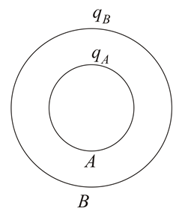D. C. Pandey Solutions for Chapter: Electrostatics, Exercise 3: Comprehension Based Questions
D. C. Pandey Physics Solutions for Exercise - D. C. Pandey Solutions for Chapter: Electrostatics, Exercise 3: Comprehension Based Questions
Attempt the free practice questions on Chapter 1: Electrostatics, Exercise 3: Comprehension Based Questions with hints and solutions to strengthen your understanding. Complete Study Pack for Engineering Entrances Objective Physics Vol 2 solutions are prepared by Experienced Embibe Experts.
Questions from D. C. Pandey Solutions for Chapter: Electrostatics, Exercise 3: Comprehension Based Questions with Hints & Solutions
Assertion: Two charges each are fixed at two points. If a third charge is placed at centre, then this charge is in stable equilibrium condition line joining the charges.
Reason: Electrostatic potential energy of the system in this position is minimum.
Assertion: Two concentric spherical shells and are charged by charges and . If is negative, then is also negative.

Reason: . Therefore, if is negative, then is also negative.
Assertion: Two identical balls are charged by . They are suspended from a common point by two insulating threads each. In equilibrium, the angle between the threads is . (Ignore gravity)
Reason: In equilibrium tension in the springs is
Assertion: With the help of Gauss theorem, we can find electric field at any point.
Reason: Gauss theorem can be applied for any type of charge distribution.
Assertion: When a capacitor is charged by a battery half of the energy supplied by the battery is stored in the capacitor and the rest half is lost.
Reason: If resistance in the circuit is zero, then there will be no loss of energy.
Assertion: A point charge produces a uniform electric field.
Reason: Due to a point charge electric lines of forces are parallel and equidistant.
Assertion: When a metallic plate is partially inserted between the plates of a capacitor its capacity increases.
Reason: If conductivity of conducting plate is more, increase in capacity will be more.
Assertion: No work is done in moving an electric dipole transnationally in uniform electric field.
Reason: Net force on electric dipole in uniform electric field is zero.
